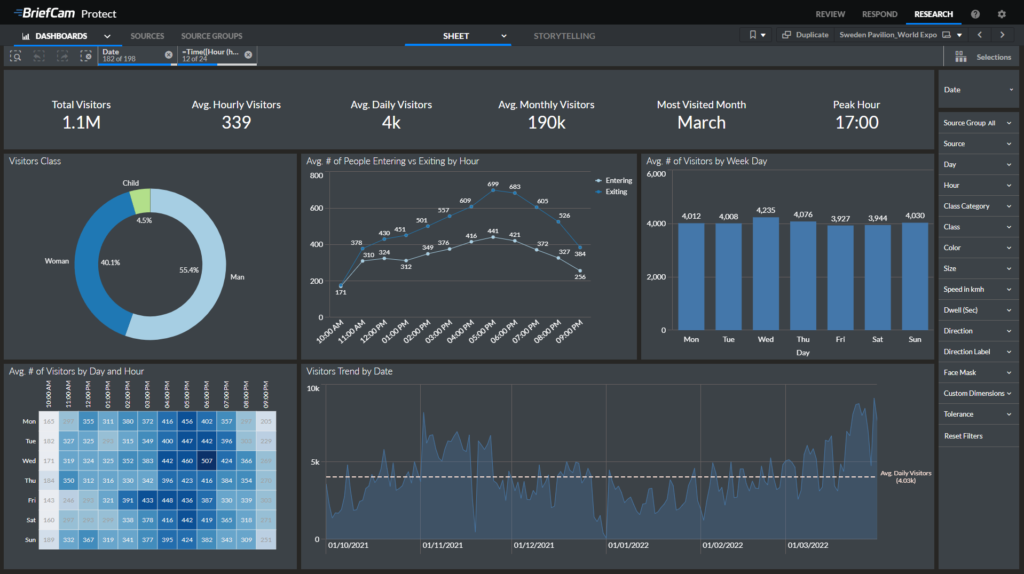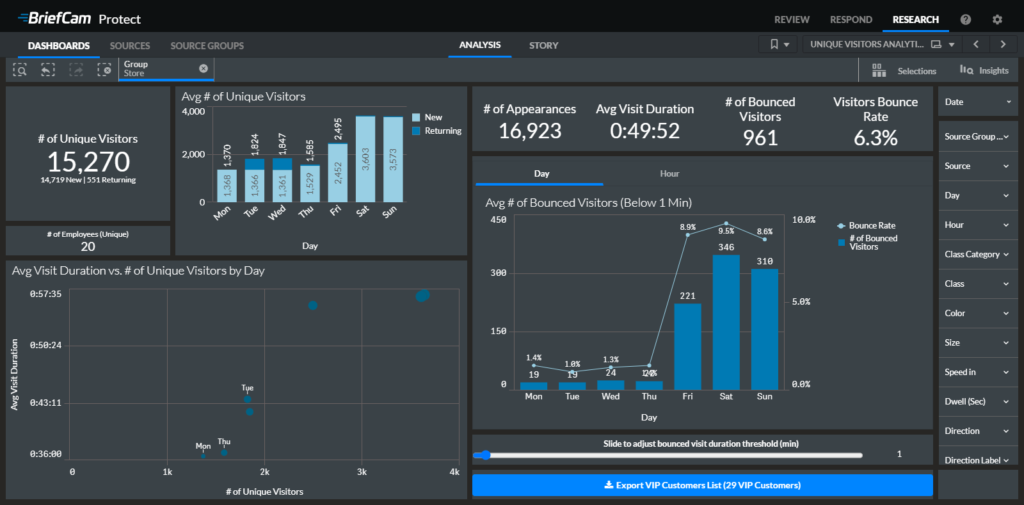Words by Lizzi Goldmeier, Director of Marketing, BriefCam
Stadiums host hundreds of events with many thousands of visitors per year, so large-scale security systems are a must. And though video surveillance systems are commonly leveraged by venues of all sizes for physical security purposes, the benefits of video surveillance extend far beyond safety and security when paired with the right software. Video content analytics solutions can help stadiums optimize the guest experience, operations, marketing, sales, and more.
What is video content analytics?
Video content analytics is an AI-based technology that transforms video surveillance content into valuable data intelligence by identifying and classifying objects and behaviors of interest in video, then indexing aggregated video object metadata to make video footage searchable, actionable, and quantifiable. In other words, video analytics users can search and filter, trigger alerts, and visualize classifications of objects detected in video, such as gender, vehicle type, clothing or vehicle color, as well as speed, path, direction, and dwell time. This can be used for rapidly and accurately investigating and responding to security incidents with AI-driven search and alerting capabilities. However, it also empowers decision-makers across the organization to monitor visitor activity trends and derive valuable insights for increasing operational efficiency and elevating guest experiences.

For example, by visualizing video metadata in dashboards and heatmaps, operators can easily understand operational trends and patterns related to visitor interactions, demographics, traffic hotspots, and vehicle or pedestrian movement patterns in and around a stadium property. This actionable business intelligence can be shared across business units and be aggregated with information from other sources to enable managers to make data-driven decisions for improving safety, operational efficiency, and guest engagement. For instance, if security operators notice heavy traffic patterns at one stadium entrance, they can proactively place signage to disperse traffic, thus creating shorter queues, faster entry, and a more positive guest experience. Security also benefits from this kind of visualized data as it helps them mitigate overcrowding in the stadium and bottle necks on the roads and parking lots in the immediate vicinity. From security to operations, retail, marketing, and project management, a wide variety of departments and stakeholders can leverage the video intelligence derived from existing security surveillance investments to resolve critical operational challenges and improve daily management of the venue.
Accelerate Investigations
When a security incident occurs at a stadium, whether in the stands, a parking lot, or even at a concession stand, security operators rely heavily on video review to bring swift resolution to the situation. Raw video data can be sufficient in some case, but when paired with the right video analytics tools, operators can rapidly pinpoint people, vehicles, and objects across multiple cameras based on attributes such as gender, size, clothing, color, direction and speed to quickly identify persons of interest.
For instance, accelerated resolution of theft cases is one way video search features can support stadium security. Not only does it provide elevated scene understanding by allowing security personnel to search and filter based on known details instead of combing through video manually, but it also increases operational efficiency by drastically reducing the time burden on security operators. Similarly, when a stadium experiences safety incidents such as personal injury, security stakeholders can quickly review video, understand what went wrong retroactively, and address liability claims with solid evidence.
Video analytics also provides exponential value to stadiums in missing persons cases such as a child being separated from a caregiver. When a person is reported missing, law enforcement can gain insight into the case by filtering video to understand when the person disappeared, whether they were with anyone else, and where they were detected across multiple cameras. This situational awareness can help security stakeholders determine whether the missing child is in danger and provide leads as to where they might be found to quickly reunite the child with their caregiver.
Track & Control Occupancy
Stadiums come in all shapes and sizes, but many event spaces have between 30-40 entrances which can create significant bottleneck difficulties. With data visualization reports generated by video content analytics, operations and security staff can see which entrances and exits are used the most and detect entry and exit trends. By assessing visitor traffic trends over time, venues can prevent bottlenecks by redirecting with appropriate signage and barriers or assigning additional staff to monitor high traffic entrances. This ensures a safer and more enjoyable visitor experience and has the added benefit of enhancing stadium operational efficiency.

Using path data can maintenance personnel can also facilitate efficient upkeep. With the ability to identify when a set number of guests have entered an area, building maintenance managers can prioritize the cleaning of high-traffic areas like restrooms.
Give Visitors More of What They Like
Understanding the ways visitors navigate a space, interact with objects and displays, and congregate throughout a stadium also provides marketing and concessions departments the benefit of video business intelligence. By analyzing dashboard visualizations and accurate representations of most highly trafficked food, beverage, and merchandise stands at the stadium, these executives can discover insights behind what makes these venues so popular and create strategies to replicate their success throughout the stadium. Similarly, video analytics can also be used to learn more about visitor demographics and movements throughout the stadium. This can help venues make intelligent decisions about events, performances, and advertisements that will appeal to their core audience, while also implementing strategies to attract other demographics more effectively.
With the ultimate goal of a positive guest experience driving strategic stadium decision-making, video technology enables security, marketing, and operations managers to realize the opportunities in their vast video investments. The power to understand their audience, manage traffic flows, maintain a safe atmosphere, and delegate duties accordingly are just a few of the ways video analytics can bring stadium video surveillance to the next level. Together, this information can be used to give visitors a great experience that they will never forget.





